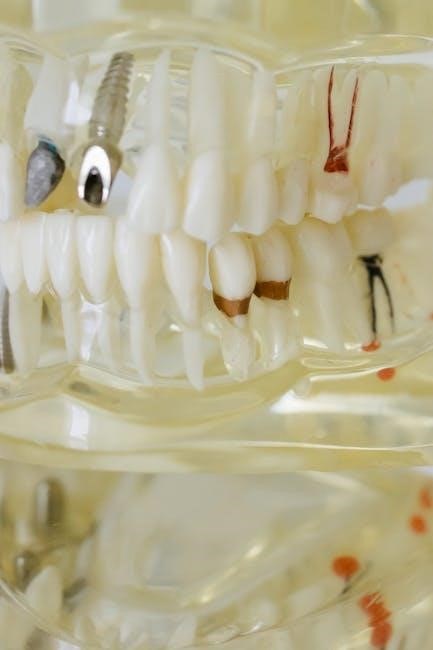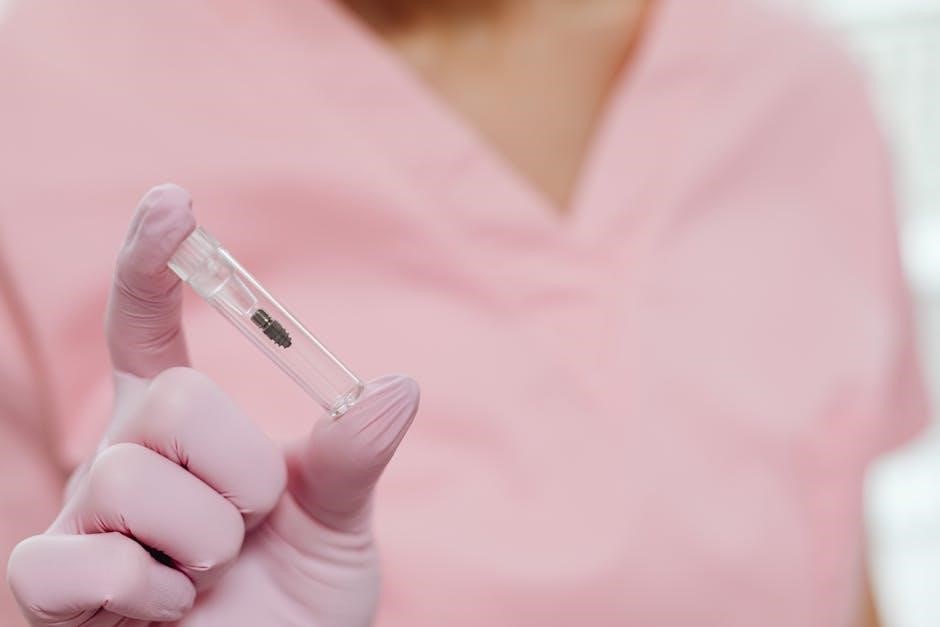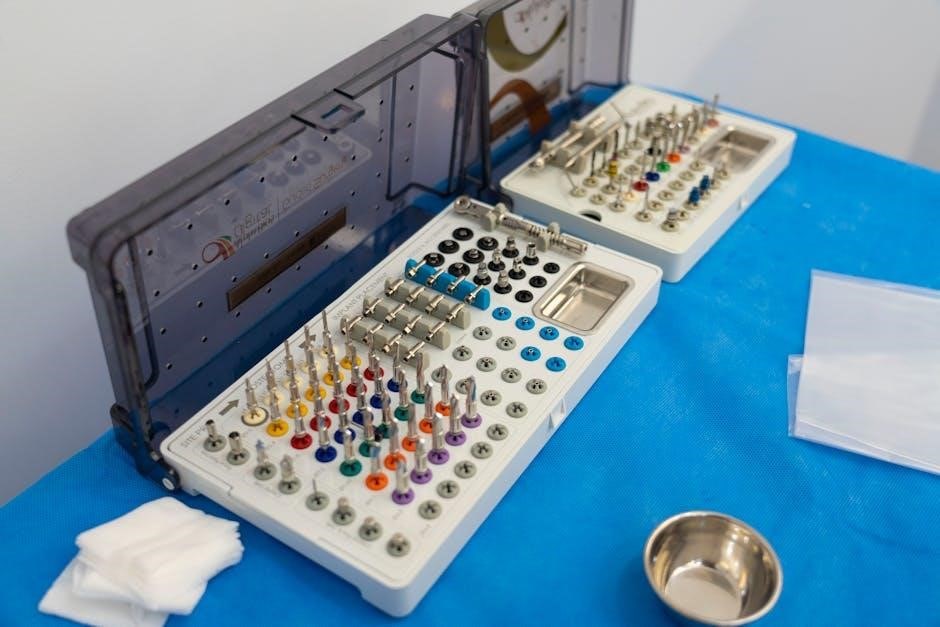Overview of Dental Implant Post-Operative Care
Proper post-operative care is crucial for healing and implant success. Patients should rest, avoid strenuous activities, and follow dietary guidelines. Ice reduces swelling, while pain medications manage discomfort. Keeping the surgical site clean and avoiding harmful habits like smoking ensure optimal recovery and implant integration.
1.1 Immediate Post-Surgery Instructions
- Avoid disturbing the surgical area for 24 hours.
- Do not rinse, spit, or use straws for the first 24 hours.
- Apply ice packs to reduce swelling.
- Consume only liquids or soft foods for the first 24 hours.
- Avoid hot liquids and smoking for at least 10 days.
1.2 Importance of Following Post-Op Instructions
Following post-operative instructions ensures proper healing, prevents complications, and promotes successful implant integration. Neglecting care can lead to issues like infection or implant failure. Adhering to guidelines helps maintain a healthy blood clot, reduces swelling, and supports the recovery process. Compliance is key for achieving optimal results and a smooth transition to the next stage of treatment.
Pain Management After Dental Implant Surgery
Pain is typically manageable with prescribed medications and comfort measures. Patients should follow medication schedules and monitor discomfort levels to ensure a smooth recovery process.
2.1 Prescribed Pain Medications
Pain management is crucial for comfort after dental implant surgery. Prescribed medications, such as opioids or NSAIDs, are typically provided to alleviate discomfort. Patients should follow the dosage instructions carefully to avoid overmedication. It’s important to take pain relievers as directed to ensure proper healing and minimize distress. If pain persists or worsens, contacting the dentist for further guidance is recommended to adjust the treatment plan effectively.
2.2 Managing Discomfort and Swelling
Swelling and discomfort are common after dental implant surgery, peaking 2-3 days post-procedure. Applying ice packs to the affected area can reduce swelling. Elevating the head while resting helps minimize facial swelling. Avoiding strenuous activities and adhering to a soft diet further supports recovery. Gentle care and patience are essential during this healing phase to ensure proper tissue repair and comfort. Following these steps helps minimize discomfort and promotes a smooth recovery process.

Dietary Recommendations
A soft food diet is recommended for the first week post-surgery. Avoid hard, sticky, or sharp foods to prevent discomfort or implant damage. Nutritional balance supports healing.
3.1 Soft Food Diet for the First Week
A soft food diet is essential for the first week after dental implant surgery. Opt for foods like yogurt, scrambled eggs, mashed potatoes, and soft-cooked vegetables. Avoid hard, sticky, or sharp foods that could irritate the surgical site. Blending meals or using a food processor can help make eating easier. Stay hydrated with cool liquids, but avoid using straws. Proper nutrition supports healing, so ensure meals are balanced and nutrient-rich.
3;2 Avoiding Hard or Sticky Foods
Avoid hard or sticky foods, such as nuts, chips, or caramel candies, for several weeks after surgery. These foods can dislodge the blood clot or irritate the implant site, delaying healing. Opt for soft, gentle options like bananas, avocados, or cooked pasta. Cutting food into small pieces can also reduce strain on the surgical area. Avoiding these foods helps protect the implant and ensures proper healing and integration with the jawbone.
3.3 Nutritional Considerations for Healing
A balanced diet rich in protein, vitamin C, and calcium supports healing after dental implant surgery. Protein aids tissue repair, while vitamin C promotes collagen synthesis. Calcium and vitamin D are essential for bone health and implant integration. Include foods like lean meats, fish, eggs, and dairy products. Omega-3 fatty acids from fatty fish or flaxseeds can reduce inflammation. Proper nutrition enhances recovery, ensuring the implant site heals effectively and integrates with the jawbone.

Oral Hygiene Practices
Maintain oral hygiene by gently brushing teeth and avoiding the surgical site for 3 days. Use recommended mouthwashes for rinsing. Keep the area clean to promote healing and prevent complications.
4.1 Cleaning the Surgical Site
Gently clean the surgical area with a soft toothbrush and mild toothpaste, avoiding direct contact with the implant site for the first 3 days. After 24 hours, rinse with recommended mouthwash to reduce bacteria and promote healing. Avoid vigorous swishing or spitting, which could dislodge the blood clot. Keeping the site clean prevents infection and supports proper tissue integration around the implant.
4.2 Resuming Regular Brushing
Resuming regular brushing is crucial for oral hygiene after dental implant surgery. Use a soft toothbrush and gentle strokes, avoiding the surgical site for the first 3-4 days. After this period, carefully include the area around the implant, ensuring not to irritate the gums. This promotes healing, prevents infection, and maintains a clean environment for proper implant integration and tissue recovery.
4.4 Rinsing with Recommended Mouthwashes
Rinsing with chlorhexidine or antibacterial mouthwashes is advised to maintain surgical site cleanliness. Start 24 hours post-surgery, rinse gently twice daily for 1-2 weeks. Avoid vigorous swishing to prevent dislodging the blood clot. This helps reduce bacteria, promotes healing, and minimizes the risk of infection, ensuring a smooth recovery and successful implant integration.

Swelling and Bruising
Swelling and bruising are common after dental implant surgery. Swelling typically peaks 2-3 days post-procedure and may last up to a week. Applying ice packs and keeping the head elevated minimizes swelling and promotes healing.
5.1 Normal Expectations
Swelling and bruising are normal after dental implant surgery. Swelling typically reaches its peak 2-3 days post-procedure and may last for up to a week. Bruising may appear around the surgical site and can extend to the neck or jaw area. These symptoms are temporary and usually resolve on their own. Applying ice packs and elevating the head can help reduce swelling. Patients should monitor their symptoms and contact their dentist if swelling persists or worsens.
5.2 Reducing Swelling with Ice
Applying an ice pack wrapped in a cloth to the swollen area can help reduce swelling. Use the ice pack for 15-20 minutes every hour during the first 24-48 hours. Keep the head elevated with pillows to minimize facial swelling. Avoid direct contact of ice with the skin to prevent discomfort. This method is effective in reducing post-surgical inflammation and promoting faster healing.
Smoking and Alcohol Consumption
Avoid smoking for 10 days and alcohol for 48 hours post-surgery. Both habits can disrupt blood clot formation, impair healing, and reduce implant success rates significantly.
6.1 Avoiding Smoking for 10 Days
Smoking should be avoided for at least 10 days after dental implant surgery. Smoking disrupts blood clot formation, delays healing, and reduces oxygen flow to the surgical site, increasing the risk of implant failure. Avoiding smoking promotes a healthier recovery and ensures proper implant integration. This precaution is critical during the initial healing phase to achieve the best possible outcomes for your dental implant procedure.
6.2 Avoiding Alcohol for 48 Hours
Alcohol consumption should be avoided for 48 hours post-surgery. Alcohol can interfere with blood clotting, prolong healing, and increase the risk of complications. It may also interact with prescribed pain medications, leading to adverse effects. Staying hydrated with water or cool liquids is recommended instead to support recovery and maintain the health of the surgical site during the critical initial healing phase.
Activity Levels
Rest is essential immediately after surgery. Avoid strenuous activities like heavy lifting or exercise for 1 week. Resume normal activities gradually to ensure proper healing and recovery.
7.1 Rest and Avoiding Strenuous Activity
Rest is crucial after dental implant surgery to promote healing. Patients should avoid strenuous activities, heavy lifting, and exercises like jogging or aerobics for at least one week. Engaging in such activities can disrupt the surgical site and impair the healing process. Staying inactive allows the body to focus its energy on recovery, ensuring proper integration of the implant. Elevating the head while resting can also help reduce swelling and discomfort.
7.2 Resuming Normal Activities Gradually
Patients can gradually resume normal activities after the initial recovery period. Light activities may be restarted within a week, but strenuous exercises like jogging or heavy lifting should be avoided for 2-3 weeks. It’s important to listen to your body and avoid actions that cause discomfort or strain. Balancing rest and gradual activity ensures proper healing and implant integration without complications. Always follow your dentist’s specific guidance for a smooth recovery.

Follow-Up Care
Regular check-ups are essential to monitor healing progress. Sutures may need removal, and your dentist will ensure proper implant integration. Address any concerns promptly for optimal results.
8.1 Scheduling Post-Operative Appointments
Scheduling follow-up appointments is vital for monitoring healing progress. Typically, the first visit occurs within 1-2 weeks to assess recovery and remove sutures. Subsequent appointments ensure proper implant integration and address any concerns. Patients should attend all scheduled visits to prevent complications and ensure a smooth recovery process. Regular check-ups also allow for timely adjustments and promote long-term implant success and stability.
8.2 Stage 2 Surgery and Implant Exposure
Stage 2 surgery involves exposing the implant for the final restoration. This procedure typically occurs 4-6 months after initial placement, allowing sufficient healing. The dentist removes the healing cap, attaches an abutment, and secures a temporary crown. This step ensures proper positioning and prepares the implant for the permanent prosthesis. Patients may experience mild discomfort, but full healing and functionality follow shortly after this procedure.

Emergency Situations
Severe pain, excessive bleeding, swelling, or implant mobility are signs of complications. Contact your dentist immediately if these occur, as prompt intervention is essential for resolution and implant success.
9.1 Signs of Complications
Signs of complications after dental implant surgery include severe pain, excessive swelling, heavy bleeding, or implant mobility. Other indicators may involve fever, pus, or prolonged numbness. Monitor these symptoms closely, as they may signal infection or improper healing. Immediate consultation with your dentist is crucial to address potential issues promptly and ensure the success of the implant procedure.
9.2 When to Contact Your Dentist
Contact your dentist if you experience severe pain, swelling, or bleeding that doesn’t subside. Other concerning signs include fever, implant mobility, or persistent numbness. Notify your dentist immediately if you notice pus or unusual discharge. These symptoms may indicate complications requiring urgent attention to prevent implant failure and ensure proper healing. Timely communication is key for effective treatment and a successful recovery.
